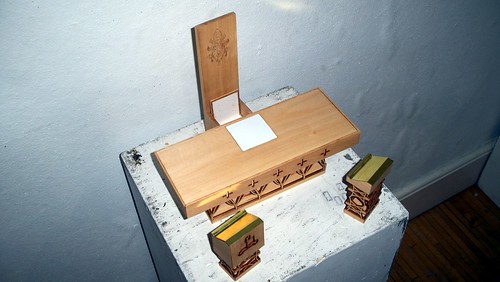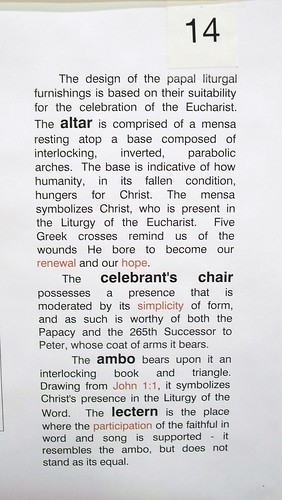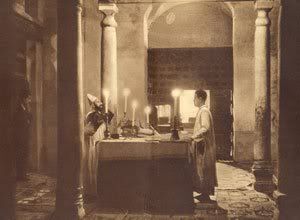The following articles are from
prodeoetpatria:
 Story By Joseph Madrinan
Story By Joseph Madrinan
Photos by Armand La Morte and Fidel Cenir
In his immaculate white cassock buttoned with the purple of his Episcopal office, and his zucchetto, Father Bishop Gregorio (forgive the imprecise term, this is my term of endearment for every bishop) processed towards the prie-dieu especially prepared for him. From there he recited some prayers ( I wonder if it was the little hour of Terce, but quite probably it wouldn’t have been, otherwise it should have taken longer), and then started vesting. Washing his hands, a carry-over practice from the ablutions Jews do, he then proceeded to putting on the amice, then the festal alb, followed by the cincture. These pieces of priestly vestments, for the average Catholic nowadays, would seem to be museum pieces, something you only get to see, but you actually don't wear. During this time, the first chaplain, Fr. Jojo assisted him with the help of the Sacristan Mayor of PLDM. Tying the cincture half-way through, Father Bishop then put on his stole, symbol of priestly authority, followed by a beautiful golden chasuble, as the mass was votive to the Blessed Trinity. Finally, on his left arm, he wore the golden maniple. It was simply lovely, a bishop who in front of all the faithful transformed from his simple soutane, to the ornate priestly attire he wore for that day’s Mass: truly it was a sight to behold. As I was recalling this event, I can’t help to remember the word’s of Our Lord to Peter saying when he becomes old, even his belt will have to be put on by his servants.
something you only get to see, but you actually don't wear. During this time, the first chaplain, Fr. Jojo assisted him with the help of the Sacristan Mayor of PLDM. Tying the cincture half-way through, Father Bishop then put on his stole, symbol of priestly authority, followed by a beautiful golden chasuble, as the mass was votive to the Blessed Trinity. Finally, on his left arm, he wore the golden maniple. It was simply lovely, a bishop who in front of all the faithful transformed from his simple soutane, to the ornate priestly attire he wore for that day’s Mass: truly it was a sight to behold. As I was recalling this event, I can’t help to remember the word’s of Our Lord to Peter saying when he becomes old, even his belt will have to be put on by his servants.
As the bishop passed on from his daily attire to that of high priest, the faithful can’t help but be reminded that truly, the bishop becomes an alter christus, he no longer is just one among us, but another Christ, about to offer the same sacrifice of the Cross!
Intoning the Judica me, Fr. Bishop officially began the mass with the antiphon, Introibo ad altare Dei, I shall enter the altar of the Lord! Those who say the TLM is never interactive should have heard how the church resounded with the dialogue that ensued during the Judica me. Just because something is in Latin doesn’t really mean nobody will be able to respond, that simply is a fallacy, and all the more I would doubt that the ones who came on that day’s mass were the ferment of society, or the literati or some intellectual whackoes, No, they were simple-minded faithful.
 Fr. Bishops sweet, flowing Latin was interrupted when he reread the day’s epistle and Gospel in English, and then providing a brief homily. There, he quoted profusely from the Motu Proprio Summorum Pontificum (MP) and its accompanying explanatory letter. He talked of how, beyond reconciliation and unity, the MP was truly about providing the richness of Catholic Tradition to everyone and that it was about enriching both ordinary and extraordinary forms. To cap his homily filled with a Litany of Thanksgiving, he said, finally I offer this mass to you, who have been devoted to this mass. There he was, a bishop who truly understood the mind of the Holy Father, a true and loyal son of Holy Mother the Church, a pastor bonus, a gift of God to his people.
Fr. Bishops sweet, flowing Latin was interrupted when he reread the day’s epistle and Gospel in English, and then providing a brief homily. There, he quoted profusely from the Motu Proprio Summorum Pontificum (MP) and its accompanying explanatory letter. He talked of how, beyond reconciliation and unity, the MP was truly about providing the richness of Catholic Tradition to everyone and that it was about enriching both ordinary and extraordinary forms. To cap his homily filled with a Litany of Thanksgiving, he said, finally I offer this mass to you, who have been devoted to this mass. There he was, a bishop who truly understood the mind of the Holy Father, a true and loyal son of Holy Mother the Church, a pastor bonus, a gift of God to his people.

The silence that followed during the Canon Missae rendered more solemnity to the occasion, to this joyous day when two scores after the Pauline reforms, once again a Philippine Church resounded with the silent, almost whispering prayer of a bishop, about to bring Calvary present once more, in the Mass.
 When the mass was technically done and the final blessing was given, the elaborate ceremonial of the Extraordinary Form doesn’t stop yet. In fact, first, it calls for thanksgiving in the reading of the first chapter of John, and then prayers of petitions to Our Blessed Mother and to St. Michael, for the conversion of sinners, the exaltation of Holy Mother the Church and the defeat of the enemy. Fr. Bishop, all the more did these with a distinct affection one can almost feel when he recited the 3 Ave Mariae and the Prayer to St Michael.
When the mass was technically done and the final blessing was given, the elaborate ceremonial of the Extraordinary Form doesn’t stop yet. In fact, first, it calls for thanksgiving in the reading of the first chapter of John, and then prayers of petitions to Our Blessed Mother and to St. Michael, for the conversion of sinners, the exaltation of Holy Mother the Church and the defeat of the enemy. Fr. Bishop, all the more did these with a distinct affection one can almost feel when he recited the 3 Ave Mariae and the Prayer to St Michael.
 After taking off the sacred vestments, Fr. Bishop spent some moments of silence thanking God for what had just happened, afterwards and to no surprise, droves of the faithful “drowned” him, all wanting to take their chance to gain an indulgence by kissing his Episcopal ring, but more than that, to offer their thanks and the warmth of their affection to such a bishop who, to my own recollection, did what simply was a miracle.
After taking off the sacred vestments, Fr. Bishop spent some moments of silence thanking God for what had just happened, afterwards and to no surprise, droves of the faithful “drowned” him, all wanting to take their chance to gain an indulgence by kissing his Episcopal ring, but more than that, to offer their thanks and the warmth of their affection to such a bishop who, to my own recollection, did what simply was a miracle.
As I am just 22, truly what I saw today was something I haven’t seen in my whole life, and thus I too thank Fr. Bishop for the “miracle” of the Holy Mass he has celebrated today.
 Story by Armand La Morte
Story by Armand La Morte
Photos by Armand La Morte and Fidel Cenir
This morning witnessed another great and historic triumph of Tradition, as His Grace, Camillo Gregorio D.D., the Bishop of Batanes, culminated his apostolic priesthood once more as he offered the Sacrifice of the Mass, in the extraordinary form of the Roman rite - the Tridentine rite, at the Parish of Our Lord of the Divine Mercy, in Cubao, Q.C. It is another affirmation from God, that the Traditional Catholic movement is on the right path, and that the restoration of the Church, particularly here in Metro Manila, is well on its way.
 The persecuted Bishop, who fought hard on the side of Tradition in his previous Diocese, seemingly mimicked the thanksgiving of St. Athanasius of Alexadria, for the continuing restoration of the Church. In his homily, His Grace thanked Our Lord and the Holy Father for the gift of Summorum Pontificum. He affirmed and highlighted some points of what Pope Benedict XVI, intends for the Church, namely the healing of rifts and dissentions among Catholics, and the unity of the Church, as the two valid forms of the Roman rite "enriches one another". His Grace also expressed his thanks and admiration to everyone present during the mass. Although the Extraordinary form was celebrated in the so-called 'Low Mass', nevertheless it was said in a very solemn manner that the people present meditatively, and enthusiastically assisted.
The persecuted Bishop, who fought hard on the side of Tradition in his previous Diocese, seemingly mimicked the thanksgiving of St. Athanasius of Alexadria, for the continuing restoration of the Church. In his homily, His Grace thanked Our Lord and the Holy Father for the gift of Summorum Pontificum. He affirmed and highlighted some points of what Pope Benedict XVI, intends for the Church, namely the healing of rifts and dissentions among Catholics, and the unity of the Church, as the two valid forms of the Roman rite "enriches one another". His Grace also expressed his thanks and admiration to everyone present during the mass. Although the Extraordinary form was celebrated in the so-called 'Low Mass', nevertheless it was said in a very solemn manner that the people present meditatively, and enthusiastically assisted.
 Fr. Jojo Zerrudo "concelebrated" (viz. according to Liturgy expert Carlos Palad, Fr. Jojo acted as 'First Chaplain') and actively served and assisted His Grace, throughout the Holy Sacrifice of the Mass. After the celebration, the people joyfully flocked towards the Bishop to ask for his blessing, and to give their thanks and honor to this great servant of Our Lord and of His Church. May the Lord be praised and all glory be unto Him. That God continually bless his servant Reverend Bishop Camillo Gregorio in giving him the strength for the apostolic burden he has received.
Fr. Jojo Zerrudo "concelebrated" (viz. according to Liturgy expert Carlos Palad, Fr. Jojo acted as 'First Chaplain') and actively served and assisted His Grace, throughout the Holy Sacrifice of the Mass. After the celebration, the people joyfully flocked towards the Bishop to ask for his blessing, and to give their thanks and honor to this great servant of Our Lord and of His Church. May the Lord be praised and all glory be unto Him. That God continually bless his servant Reverend Bishop Camillo Gregorio in giving him the strength for the apostolic burden he has received.
For once allow me to concede to the Protestants, in singing "This is the day (2x)…that the Lord has made; I will rejoice (2x) and be glad in Him."
---
I never had the experience of attending a Mass celebrated in the Extraordinary Form, but I was extremely jubilant upon Summorum Pontificum and the EF Masses celebrated here in our country.
I hope I will be able to pray the Mass of countless saints and sinners soon. After all, staying in Quezon City for my studies, I am in the same diocese as the Parish of the Lord of Divine Mercy.
 Today the winning design for the pulpit, lectern and chair that Pope Benedict will use for his public Mass at DC's Nationals stadium during his April visit was unveiled.
Today the winning design for the pulpit, lectern and chair that Pope Benedict will use for his public Mass at DC's Nationals stadium during his April visit was unveiled.The model by John-Paul Mikolajczyk, of Staten Island, N.Y., and Ryan Mullen, of Manchester, N.H., both candidates in the master's program at Catholic University's School of Architecture and Planning, shows an altar with a substantial top, a repeating pattern of decorative parabolic arches beneath it and a smaller base.
[Above photo credit: Tony Fiorini, CUA - "Ryan Mullen and John-Paul Mikolajczjk and their winning papal design." All other photographs: Thomas Peters, AmericanPapist blog.]
















